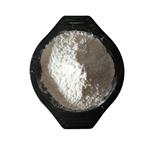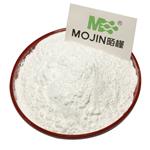Rubidium Chloride: A Versatile Compound Revolutionizing Depression Treatment and Solar Cell Efficiency
Mar 18,2024
General Description
Rubidium chloride is a halide salt discovered following the identification of rubidium in 1861 by Bunsen and Kirchhoff through flame spectroscopy. Produced by reacting rubidium compounds with hydrochloric acid, Rubidium chloride has significant applications in research and medicine, notably in treating major depression and enhancing perovskite solar cells (PSCs) efficiency and stability. In depression treatment, it has shown potential in improving mood and reducing symptoms with minor side effects. In solar energy, Rubidium chloride 's role as an interface modification layer in PSCs improves power conversion efficiency and durability by passivating defects and optimizing energy alignment, demonstrating its versatility and potential in diverse fields.

Figure 1. Rubidium chloride
Origin
Rubidium chloride is a chemical compound that belongs to the group of halide salts, consisting of rubidium and chlorine atoms. Its origin can be traced back to the discovery of rubidium itself, which was first identified in 1861 by German chemists Robert Bunsen and Gustav Kirchhoff. They discovered rubidium by using flame spectroscopy, a technique they pioneered, which revealed the element's unique spectral lines. Rubidium chloride is subsequently produced by reacting rubidium hydroxide (RbOH) with hydrochloric acid (HCl), or by treating rubidium carbonate (Rb2CO3) with hydrochloric acid. This reaction results in the formation of rubidium chloride and water or carbon dioxide as by-products. The compound is notable for its use in various scientific research fields, including biochemistry where it serves as a source of rubidium ions for studies on cell biology and neuroscience. 1
Applications
Applications in the treatment of depression
Rubidium chloride has been explored as a potential treatment for major depression, with promising results observed in a study involving 20 patients, predominantly female, with an average age of 55 years. These patients were administered doses ranging from 360 to 720 mg/day of rubidium chloride over a 60-day period. The study reported a gradual and significant improvement in depressive symptoms, as measured by the Hamilton Depression Rating Scale (HDRS) and Zung Self-Rating Depression Scale, alongside reductions in anxiety levels according to the State-Trait Anxiety Inventory (STAI X1) and Hamilton Anxiety Rating Scale (HamARS). Interestingly, there was no direct correlation found between serum levels of rubidium and clinical improvement, suggesting the mechanism of action might be independent of systemic concentration. Despite its effectiveness, some minor adverse effects were noted, including diarrhea and skin rashes. The treatment particularly improved mood, diminished negative thoughts, enhanced work and occupational interests, and reduced psychomotor retardation, addressing key aspects of depressive syndrome effectively. This suggests rubidium chloride's significant and rapid antidepressant properties, highlighting its potential role in managing mood disorders, albeit further research is needed to fully understand its efficacy and safety profile. 2
Applications in solar cells
Rubidium chloride has emerged as a significant advancement in the field of perovskite solar cells (PSCs), particularly for enhancing their efficiency and stability. In the context of solar energy, interface defects between the perovskite layer and the electron transport layer, such as SnO2, can severely impact the power conversion efficiency (PCE) and longevity of PSCs. The introduction of Rubidium chloride as an interface modification layer addresses this challenge by effectively passivating under-coordinated defects and optimizing energy level alignment between the perovskite and SnO2 layers. This optimization leads to a notable improvement in PCE, achieving a high open-circuit voltage of 1.11 V and a PCE of 21.64%. Furthermore, the durability of these solar cells is significantly enhanced, maintaining 80% of their initial efficiency after 30 days in an inert gas environment and 60% after exposure to ambient air for the same duration. The application of Rubidium chloride in solar cells underscores its potential in reducing recombination losses and improving the operational stability of PSCs, marking a promising direction for future solar energy technologies. 3
Reference
1. National Center for Biotechnology Information (2024). PubChem Compound Summary for CID 62683, Rubidium chloride.
2. Torta R, Ala G, Borio R, et al. Rubidium chloride in the treatment of major depression. Minerva Psichiatr. 1993;34(2):101-110.
3. Hu L, Shi W, Li G, Yang Y, Nie J. Utilizing rubidium chloride as an effective and stable interface modification layer for high-efficiency solar cells. Appl Opt. 2024;63(7):1702-1709.
- Related articles
- Related Qustion
- Preparation and uses of Rubidium chloride Sep 8, 2023
Rubidium chloride is a stable inorganic salt with a wide range of applications in the field of biology and optics.
Rubidium chloride
7791-11-9You may like
Rubidium chloride manufacturers
- Rubidium chloride
-

- $0.00 / 25kg
- 2025-03-21
- CAS:7791-11-9
- Min. Order: 1kg
- Purity: 99%
- Supply Ability: 50000KG/month
- Rubidium chloride
-

- $0.00 / 25kg
- 2025-03-21
- CAS:7791-11-9
- Min. Order: 1kg
- Purity: 99%
- Supply Ability: 50000KG/month
- Rubidium chloride
-

- $0.00 / 25KG
- 2025-03-21
- CAS:7791-11-9
- Min. Order: 1KG
- Purity: 99%
- Supply Ability: 50000KG/month






